Note: This website was automatically translated, so some terms or nuances may not be completely accurate.
What is the significance of running TV commercials today? Three media planners reconsider.
Television commercials once faced challenges like "time-consuming processes from order placement to airing" and "limited effectiveness measurement." Today, services that overcome these issues and update advertising on television media are increasing.
This series introduces emerging services for the increasingly sophisticated TV media landscape and showcases case studies of advertisers utilizing them. We explore how TV commercials can be effectively leveraged, considering advertisers' KPIs and challenges.
For the first installment, three media planners from Dentsu Inc. who work directly with advertisers on the front lines—Wataru Kuboya, Hiroshi Yamazaki, and Shunsuke Yoshioka—reconsider "The Significance of Advertising on Television Today." The interviewer is Rina Akino from Dentsu Inc.'s Radio,TV Business Produce Division, who is involved in developing and promoting television advertising and effectiveness measurement services.

The number of advertisers placing TV commercials has remained virtually unchanged for four years
Akino: You all belong to Dentsu Inc. Marketing Bureau and, as media planners, interact with various advertisers daily. Could you tell us what types of projects you primarily handle?
Kuboya: I primarily handle national clients in sectors like home appliances, beverages, and IT. My role involves partnership-based media strategy development, establishing approaches for effectiveness verification, and conducting specific analysis tasks. Additionally, I'm currently working on advancing and streamlining media planning using AI.
Yamazaki: I handle many clients whose daily sales and applications are easily visible, such as e-commerce sites, retail distributors, and direct-to-consumer insurance companies. I focus on how to accurately measure the effects of diverse advertising and how to connect advertising to the client's sales.
Yoshioka: My portfolio spans diverse industries including apps, games, food, event venues, and energy-related companies. I frequently focus on developing long-term advertising communication strategies with consumers.
Akino: Thank you. Recently, various SNS and OTT (*) platforms have emerged, increasing the options for advertising media. Against this backdrop, how do you view television's unique characteristics compared to other media, and the significance of placing commercials on TV?
※OTT: Over The Top. Services that deliver content to end-users via the internet across multiple devices. This includes video streaming services and services compatible with CTV.
Yoshioka: While digital media's rapid growth has sometimes led people to view TV as a medium where ads struggle to reach consumers, taking a broader view of society, I believe TV's influence remains substantial.
Kuboya: Even in terms of reach for TV commercials, I believe TV maintains its strength. The graph below shows the reach among the M1 demographic (men aged 20-34) for the top 500 companies by TV ad spend over approximately two years.
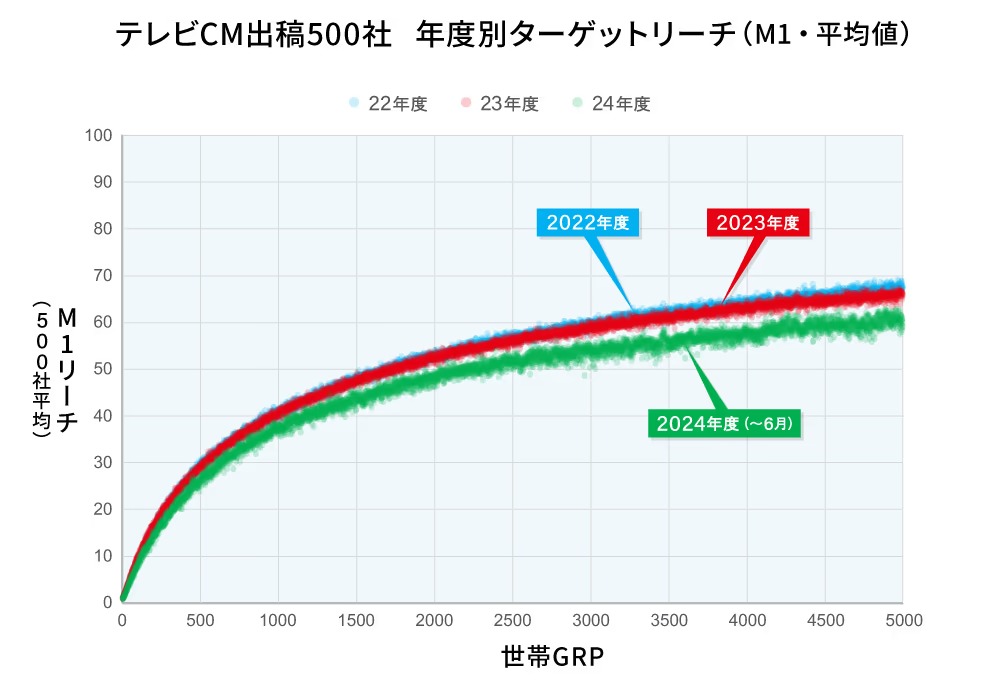
[Advertising Activity: Time or spot advertising placements by the 500 target advertisers in the Kanto region (Nippon TV, TBS, Fuji TV, TV Asahi, TV Tokyo) from April to March each year]
Kuboya: The horizontal axis represents TV GRP (Gross Rating Point: cumulative viewership rating), while the vertical axis shows the reach level to the M1 demographic.While the M1 demographic is often considered hard to reach via TV commercials, the graph shows their reach rate hasn't dropped significantly. This is likely because very few people "never watch TV at all." Instead, as the number of media platforms they consume—like SNS—has increased, more people have become "viewers who only watch specific TV programs." In other words, if you can place commercials during programs this demographic is likely to watch, you can maximize TV's reach.
Yamazaki: TV reach remains high compared to other media, but the "method of delivery" has become even more crucial than before, hasn't it?

Yoshioka: For example, placing ads during major event programs can sometimes lead to a sudden surge in reach. We need to think more deeply about what kind of content our target audience is interested in.
Akino: I see. While young people are said to be turning away from TV, it seems TV media can still maintain reach among younger demographics depending on how campaigns are planned.
Kuboya: Yes. Given this reality, many companies continue to place TV commercials. According to Video Research Ltd. survey results, the number of advertisers placing ads on TV has remained largely unchanged over the four years since 2021. While some adjust their ad volume, I believe many advertisers recognize the value of TV commercials.
It's particularly interesting that companies skilled in digital marketing have been actively placing ads on television in recent years. It seems many companies are effectively utilizing media by consciously recognizing the different roles of digital and television.
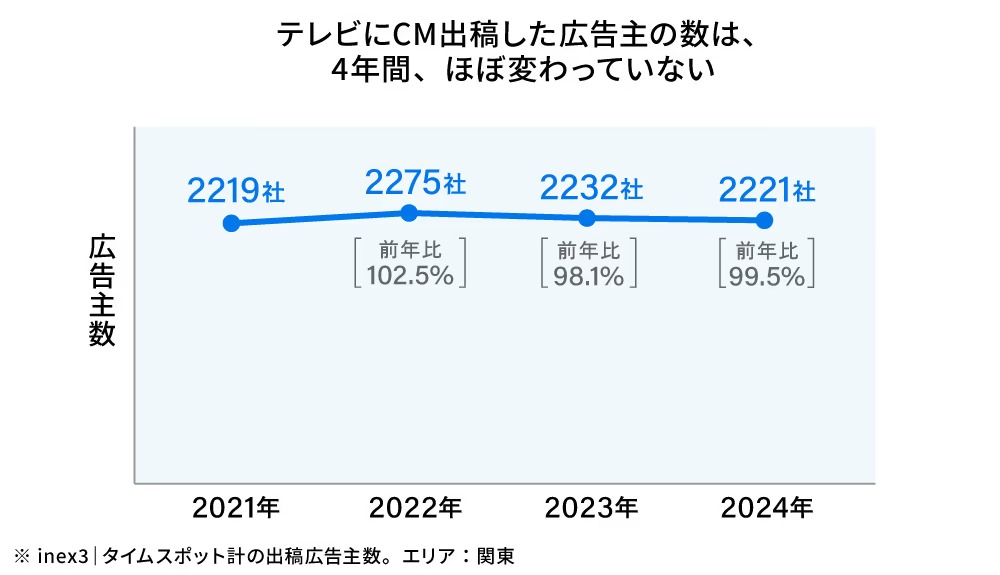
[Target: Advertisers who placed time or spot commercials in the Kanto area (Nippon TV, TBS, Fuji TV, TV Asahi, TV Tokyo) from January to December each year]
Three Scenarios Where You Might Consider TV Commercials
Akino: You all handle media planning for various advertisers on a daily basis. What kinds of situations make you consider TV commercials?
Case ①: When the target audience constitutes 10% or more of the total population
Kuboya: There are primarily three scenarios. The first is when the target audience for a product or service constitutes 10% or more of the total population. This is because TV commercials offer good cost performance. When advertising to the general public, the CPM (Cost Per Mille: cost per thousand impressions) for TV commercials is around ¥200 to ¥300.On the other hand, fully viewable digital media often costs between ¥1,500 and ¥3,500 CPM, depending on the platform. While digital media allows pinpoint targeting, for broad reach, TV is about 10 times more efficient.
Yoshioka: The fact that TV's reach efficiency is ten times higher means that if 10% of TV's audience is your target, TV offers equivalent value to digital. So, in many cases, it's worth trying TV.
Kuboya: TV commercials are also effective for capturing potential targets. Television has the aspect of "simultaneous viewing," where people across a wide age range often watch the same program together. While some might argue, "Isn't this just wasting ads on non-targets?" the market is fluid, and it's unlikely the same people will always purchase a product. You can advertise not only to the 10% who are your target, but also to the 90% potential audience who might buy in the future.

Yoshioka: I agree. For some products, you can't even identify the potential audience beforehand.
Akino: That's an interesting perspective. While TV's ability to reach audiences with low initial interest in products or categories has been discussed before, that approach is based solely on interest levels at the moment the ad is aired. By reframing it as targeting "potential future customers" and expanding the timeframe, the scope for utilizing TV commercials seems to broaden significantly.
Case ②: When Seeking Long-Term Growth
Yamazaki: The second case where TV commercials should be considered is when you want to achieve advertising effectiveness from a long-term perspective. I believe it's particularly effective when aiming for the growth of products/services (business growth) over a period of three years or more.
Let me give an example. The table below shows estimated sales growth after 1, 3, and 5 years based on a case study. It illustrates how sales grow when the budget ratio between top-funnel (awareness) media (like TV and YouTube video ads) and bottom-funnel (purchase) media (like search ads and banners) is adjusted.
The larger the percentage on the horizontal axis, the greater the budget allocation for top-funnel media. For the first-year sales growth rate, maintaining a fixed allocation to the bottom funnel yields higher growth. In other words, if the sole goal is to maximize first-year sales, targeting the bottom funnel with the budget is a valid strategy.
However, as the number of years increases, allocating more budget to the top funnel tends to yield higher growth rates. The table below also shows the top funnel budget allocation that maximizes the growth rate for each year (shown in blue). This indicates that when looking beyond the third year, a higher proportion allocated to the top funnel leads to a higher growth rate.
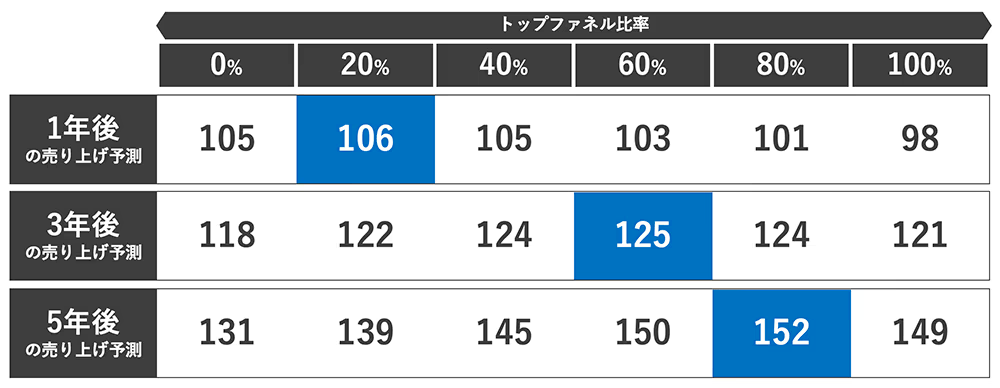
Kuboya: While the numbers may vary by industry, this feels intuitively right.
Yoshioka: Of course, not every industry or company will fit these exact cases. However, when considering long-term growth, I believe television remains highly effective.
Yamazaki: Of course, there are times when short-term sales are necessary. Therefore, it's important to think about both the top and bottom of the funnel while also generating immediate sales. Then, with the goal of increasing future sales, we should utilize various advertising effectiveness measurement services and continuously run the PDCA cycle.
Kuboya: Since many companies across categories efficiently deliver ads to the visible audience through digital marketing, it can be quite difficult to differentiate there. Hearing this discussion reaffirmed my belief that boosting consumer mindshare at the top of the funnel can be an effective strategy for mid-to-long-term growth.
Akino: Mid-to-long-term growth rates are inherently difficult to predict. That's why it's crucial for media planners like you to leverage advertising effectiveness measurement tools and accompany advertisers as their business grows.

Case 3: When You Want to Broadly Increase Awareness in a Short Time
Yoshioka: I'll cover the third case. TV commercials are also effective for short-term campaigns. Using Dentsu Inc.'s proprietary media simulation tool, a ¥250 million budget achieves 40% digital reach in one week, while TV exceeds 70%.
Yamazaki: TV commercials are also effective when you need to quickly reach a large audience, such as launching a new campaign to refresh brand image or promote limited-time products/services.
Akino: So, television is a medium well-suited for creating a large, instantaneous wave of impact across society.
Kuboya: Exactly. It's about different areas of expertise. While digital media is often consumed based on individual preferences, television has the unique characteristic of "co-viewing."
Yoshioka: The co-viewing perspective is crucial in marketing. TV commercials can become topics of conversation within families, and they have the potential to be more memorable than when watched alone.
Akino: I see. So for cases where "the target audience makes up over 10% of the total population," "long-term growth is desired," or "awareness needs to be spread quickly," it seems worthwhile to consider placing commercials on TV.

Analyzing advertising effectiveness to effectively combine TV and digital
Akino: Next, let's consider the effectiveness of TV commercials. Some say "TV ads are hard to measure," but what are your thoughts on this?
Yoshioka: Technology has advanced, enabling various analyses now. For example, we're increasingly able to track actions like visiting a product site, making a purchase, or visiting a store after seeing a TV commercial.
Furthermore, analysis using psychological indicators like product awareness and purchase intent, as well as obtaining actual behavioral data like purchases, is becoming possible. Since there are numerous cases where TV commercials effectively drive efficient purchasing behavior, even companies that excel at digital marketing continue to use television.
Akino: What specific analyses do you conduct regarding the effectiveness of TV commercials?
Yoshioka: One key metric we prioritize is "net increase in new purchasers" (the number of additional product buyers attributable to the TV commercial). Essentially, this estimates how much lower sales would have been without the TV commercial.
In 2022, Dentsu Inc. and Dentsu Digital Inc. developed "TOBIRAS," a system platform that centrally manages analysis and operations across multiple data clean room environments. Using TOBIRAS allows us to analyze TV and various digital media using exactly the same methodology. Furthermore, it enables detailed analysis of which broadcasters and regions were most efficient, allowing us to translate these insights into actionable next steps.
Kuboya: Dentsu Inc. also offers "STADIA360," an integrated marketing platform utilizing actual TV viewing data.
STADIA360 links actual TV viewing data (obtained with prior user consent) with data sets held by various data holders (surveys, websites, digital ad exposure, app measurements, entertainment, location data, purchases, customer first-party data, etc.). This enables multifaceted verification of advertising effectiveness on connected TV through large-scale ID data analysis.
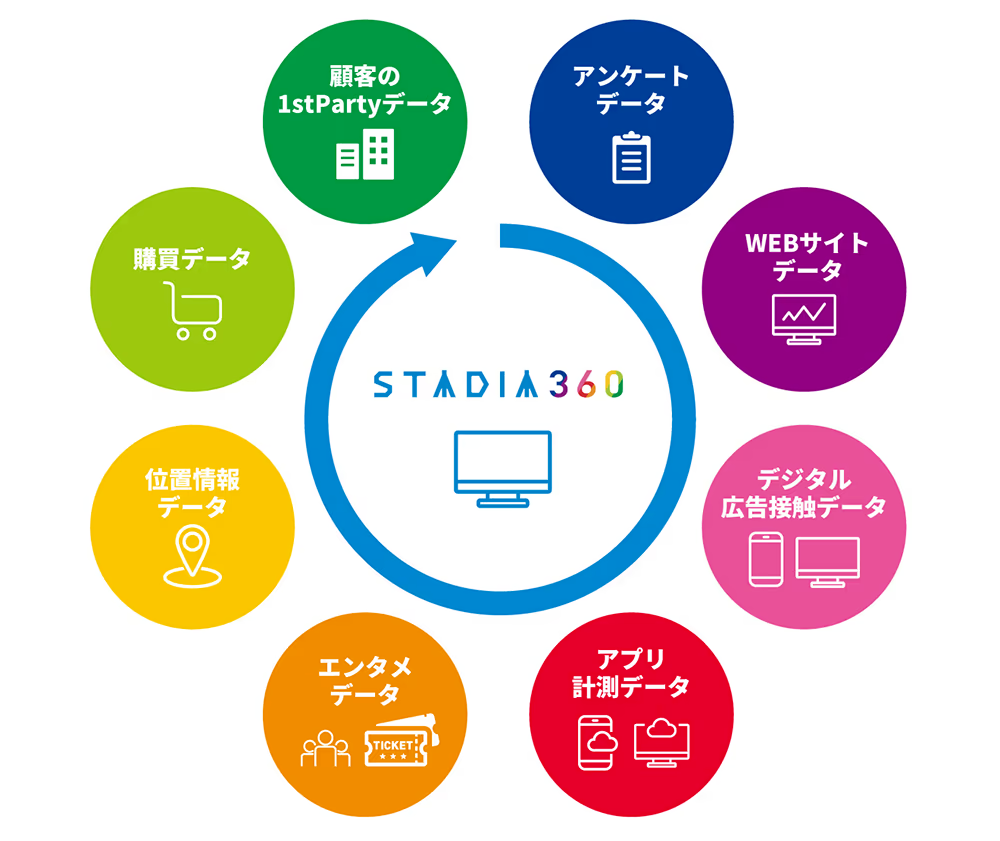
Yamazaki: For example, we can link actual TV viewing data with the smartphone IDs of people who downloaded an app, then compare results between those who saw the TV commercial and those who didn't. This clearly shows the net increase in app downloads attributable to the TV commercial campaign.
Yoshioka: We can analyze many other things too. For instance, customer acquisition efficiency for banner ads can vary significantly between TV ad campaign periods and non-campaign periods. This suggests TV commercials might be driving higher banner ad response rates. STADIA360 enables us to analyze precisely that.
Kuboya: Some people see a TV commercial and then search for the site, while others become aware of the product but take no action. Conversely, some see the commercial and directly visit a store or make a purchase. TV's impact is multifaceted. I believe we can clarify these effects too.
Yamazaki: From the advertiser's perspective, the objectives vary: raising awareness of products or services, driving search behavior, or encouraging purchases. It's crucial to set KPIs based on the specific goal and continuously improve through the PDCA cycle.
Akino: Focusing solely on specific metrics like searches or site visits only shows one aspect of advertising effectiveness. Therefore, it's necessary to identify the purpose of the TV commercial campaign and assess advertising effectiveness from multiple angles. Are there any points to be cautious about when verifying the overall effectiveness of media marketing?
Yoshioka: When desired advertising results aren't achieved, we sometimes see cases where companies stop advertising on a particular medium rather than exploring improvements for that medium.
Yamazaki: As briefly mentioned earlier, TV commercials are sometimes immediately deemed ineffective. Instead, we need to consider how combining them with other media can create synergistic effects.
Yoshioka: Exactly. Discussions often focus on whether TV or digital delivered more efficient results, or on using only the most efficient medium. However, we can also analyze the combined impact of TV and digital. It's crucial to diligently keep searching for the best-case scenario.
Akino: Hearing everyone's perspectives today has helped me reconsider the significance of running TV commercials. Starting next time, we'll explore how TV commercial placement services and effectiveness measurement services are evolving, sharing real-world examples from advertisers who've utilized them to demonstrate effective TV commercial strategies.
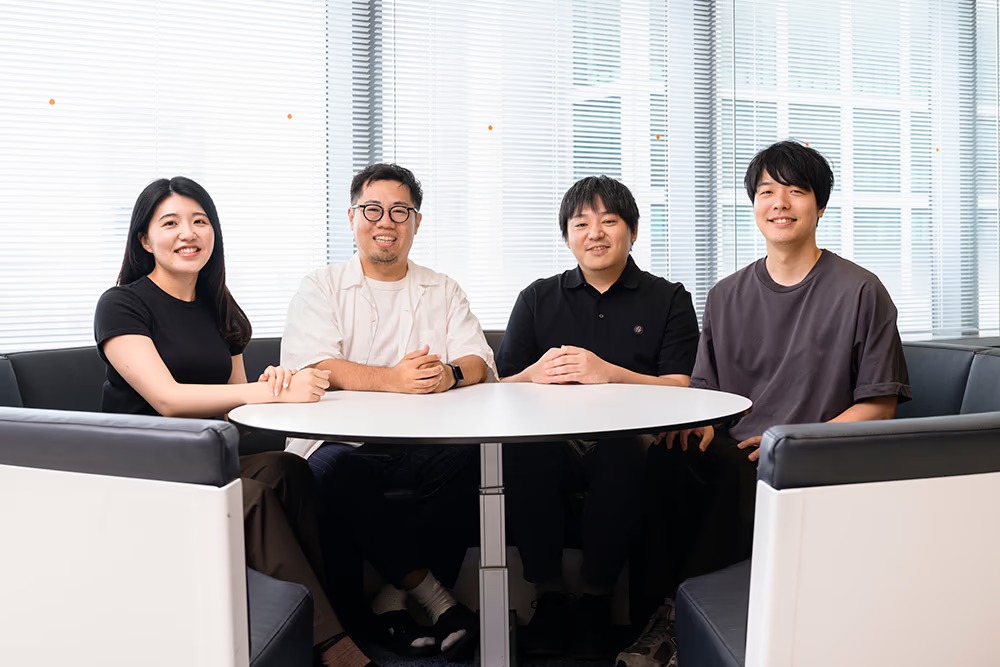
The information published at this time is as follows.
Was this article helpful?
Newsletter registration is here
We select and publish important news every day
For inquiries about this article
Author

Kō Kuboya
Dentsu Inc.
Second Integrated Solutions Bureau
Planner
Engaged in developing media and business strategies based on quantitative and qualitative data analysis. Responsible for end-to-end execution—from building data environments that drive business growth across diverse sectors (consumer goods, durable goods, B2B, apps, IT, etc.) and formulating media strategies, to implementing PDCA cycles. Proficient in both internal and external tools and solutions across television and digital domains.

Shunsuke Yoshioka
Dentsu Inc.
Marketing Division 3
Planner
メディア現場での実践経験を軸に、メディア領域全般のデータオリエンテッドなプランニングからPDCAまで幅広く、実経験に裏打ちされたプランニングを提供。長期的にクライアントと並走し、ビジネスグロースを実現していく業務を多く経験。
Articles by this person

Hiroshi Yamazaki
Dentsu Inc.
Marketing Division 1
Planner
After gaining experience in e-commerce site operations, digital advertising management, direct marketing support, and mass media buying, transitioned to integrated marketing operations. Specializes in developing data solutions that visualize business outcomes such as sales and applications, and in planning strategies to maximize business results.

Rina Akino
Dentsu Inc.
Radio,TV Business Produce Division
Joined the company in 2017. Since joining, has been involved in planning and developing next-generation TV spot business initiatives, including the development of the AI-powered viewership prediction system "SHAREST" and the programmatic TV advertising system "RICH FLOW." Since 2021, has been focused on driving digital transformation (DX) for TV time and enhancing the value of TV media.



